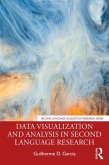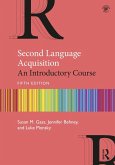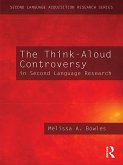Guilherme D. Garcia
Data Visualization and Analysis in Second Language Research (eBook, PDF)
39,95 €
39,95 €
inkl. MwSt.
Sofort per Download lieferbar

20 °P sammeln
39,95 €
Als Download kaufen

39,95 €
inkl. MwSt.
Sofort per Download lieferbar

20 °P sammeln
Jetzt verschenken
Alle Infos zum eBook verschenken
39,95 €
inkl. MwSt.
Sofort per Download lieferbar
Alle Infos zum eBook verschenken

20 °P sammeln
Guilherme D. Garcia
Data Visualization and Analysis in Second Language Research (eBook, PDF)
- Format: PDF
- Merkliste
- Auf die Merkliste
- Bewerten Bewerten
- Teilen
- Produkt teilen
- Produkterinnerung
- Produkterinnerung

Bitte loggen Sie sich zunächst in Ihr Kundenkonto ein oder registrieren Sie sich bei
bücher.de, um das eBook-Abo tolino select nutzen zu können.
Hier können Sie sich einloggen
Hier können Sie sich einloggen
Sie sind bereits eingeloggt. Klicken Sie auf 2. tolino select Abo, um fortzufahren.

Bitte loggen Sie sich zunächst in Ihr Kundenkonto ein oder registrieren Sie sich bei bücher.de, um das eBook-Abo tolino select nutzen zu können.
This introduction to visualization techniques and statistical models for second language research focuses on three types of data (continuous, binary, and scalar), helping readers to understand regression models fully and to apply them in their work.
- Geräte: PC
- ohne Kopierschutz
- eBook Hilfe
- Größe: 5.71MB
Andere Kunden interessierten sich auch für
![Data Visualization and Analysis in Second Language Research (eBook, ePUB) Data Visualization and Analysis in Second Language Research (eBook, ePUB)]() Guilherme D. GarciaData Visualization and Analysis in Second Language Research (eBook, ePUB)39,95 €
Guilherme D. GarciaData Visualization and Analysis in Second Language Research (eBook, ePUB)39,95 €![Second Language Acquisition (eBook, PDF) Second Language Acquisition (eBook, PDF)]() Susan M. GassSecond Language Acquisition (eBook, PDF)57,95 €
Susan M. GassSecond Language Acquisition (eBook, PDF)57,95 €![The Think-Aloud Controversy in Second Language Research (eBook, PDF) The Think-Aloud Controversy in Second Language Research (eBook, PDF)]() Melissa A. BowlesThe Think-Aloud Controversy in Second Language Research (eBook, PDF)50,95 €
Melissa A. BowlesThe Think-Aloud Controversy in Second Language Research (eBook, PDF)50,95 €![Organizational Psychology of Mergers and Acquisitions (eBook, PDF) Organizational Psychology of Mergers and Acquisitions (eBook, PDF)]() Camelia OanceaOrganizational Psychology of Mergers and Acquisitions (eBook, PDF)42,95 €
Camelia OanceaOrganizational Psychology of Mergers and Acquisitions (eBook, PDF)42,95 €![Longitudinal Studies of Second Language Learning (eBook, PDF) Longitudinal Studies of Second Language Learning (eBook, PDF)]() Longitudinal Studies of Second Language Learning (eBook, PDF)37,95 €
Longitudinal Studies of Second Language Learning (eBook, PDF)37,95 €![Second Language Research (eBook, PDF) Second Language Research (eBook, PDF)]() Alison MackeySecond Language Research (eBook, PDF)37,95 €
Alison MackeySecond Language Research (eBook, PDF)37,95 €![Researching Creativity in Second Language Acquisition (eBook, PDF) Researching Creativity in Second Language Acquisition (eBook, PDF)]() Ashleigh PipesResearching Creativity in Second Language Acquisition (eBook, PDF)37,95 €
Ashleigh PipesResearching Creativity in Second Language Acquisition (eBook, PDF)37,95 €-
-
-
This introduction to visualization techniques and statistical models for second language research focuses on three types of data (continuous, binary, and scalar), helping readers to understand regression models fully and to apply them in their work.
Dieser Download kann aus rechtlichen Gründen nur mit Rechnungsadresse in A, B, BG, CY, CZ, D, DK, EW, E, FIN, F, GR, HR, H, IRL, I, LT, L, LR, M, NL, PL, P, R, S, SLO, SK ausgeliefert werden.
Produktdetails
- Produktdetails
- Verlag: Taylor & Francis eBooks
- Seitenzahl: 286
- Erscheinungstermin: 30. Mai 2021
- Englisch
- ISBN-13: 9781000394580
- Artikelnr.: 61429687
- Verlag: Taylor & Francis eBooks
- Seitenzahl: 286
- Erscheinungstermin: 30. Mai 2021
- Englisch
- ISBN-13: 9781000394580
- Artikelnr.: 61429687
- Herstellerkennzeichnung Die Herstellerinformationen sind derzeit nicht verfügbar.
Guilherme D. Garcia is Assistant Professor of Linguistics at Ball State University, USA.
Contents
List of figures
List of tables
List of code blocks
Acknowledgments
Preface
Part I Getting ready
1 Introduction
1.1 Main objectives of this book
1.2 A logical series of steps
1.2.1 Why focus on data visualization techniques?
1.2.2 Why focus on full-fledged statistical models?
1.3 Statistical concepts
1.3.1 p-values
1.3.2 Effect sizes
1.3.3 Confidence intervals
1.3.4 Standard errors
1.3.5 Further reading
2 R basics 23
2.1 Why R?
2.2 Fundamentals
2.2.1 Installing R and RStudio
2.2.2 Interface
2.2.3 R basics
2.3 Data frames
2.4 Reading your data
2.4.1 Is your data file ready?
2.4.2 R Projects
2.4.3 Importing your data
2.5 The tidyverse package
2.5.1 Wide-to-long transformation
2.5.2 Grouping, filtering, changing, and summarizing data
2.6 Figures
2.6.1 Using ggplot2
2.6.2 General guidelines for data visualization
2.7 Basic statistics in R
2.7.1 What's your research question?
2.7.2 t-tests and ANOVAs in R
2.7.3 A post-hoc test in R
2.8 More packages
2.9 Additional readings on R
2.10 Summary
2.11 Exercises
Part II Visualizing the data
3 Continuous data
3.1 Importing your data
3.2 Preparing your data
3.3 Histograms
3.4 Scatter plots
3.5 Box plots
3.6 Bar plots and error bars
3.7 Line plots
3.8 Additional readings on data visualization
3.9 Summary
3.10 Exercises
4 Categorical data
4.1 Binary data
4.2 Ordinal data
4.3 Summary
4.4 Exercises
5 Aesthetics: optimizing your figures
5.1 More on aesthetics
5.2 Exercises
Part III Analyzing the data 127
6 Linear regression 129
6.1 Introduction
6.2 Examples and interpretation
6.2.1 Does Hours affect scores?
6.2.2 Does Feedback affect scores?
6.2.3 Do Feedback and Hours affect scores?
6.2.4 Do Feedback and Hours interact?
6.3 Beyond the basics
6.3.1 Comparing models and plotting estimates
6.3.2 Scaling variables
6.4 Summary
6.5 Exercises
7 Logistic regression
7.1 Introduction
7.1.1 Defining the best curve in a logistic model
7.1.2 A family of models
7.2 Examples and interpretation
7.2.1 Can reaction time differentiate learners and native speakers?
7.2.2 Does Condition affect responses?
7.2.3 Do Proficiency and Condition affect responses?
7.2.4 Do Proficiency and Condition interact?
7.3 Summary
7.4 Exercises
8 Ordinal regression
8.1 Introduction
8.2 Examples and interpretation
8.2.1 Does Condition affect participants' certainty?
8.2.2 Do Condition and L1 interact?
8.3 Summary
8.4 Exercises
9 Hierarchical models
9.1 Introduction
9.2 Examples and interpretation
9.2.1 Random-intercept model
9.2.2 Random-slope and random-intercept model
9.3 Additional readings on regression models
9.4 Summary
9.5 Exercises
10 Going Bayesian
10.1 Introduction to Bayesian data analysis
10.1.1 Sampling from the posterior
10.2 The RData format
10.3 Getting ready
10.4 Bayesian models: linear and logistic examples
10.4.1 Bayesian model A: Feedback
10.4.2 Bayesian model B: Relative clauses with prior specifications
10.5 Additional readings on Bayesian inference
10.6 Summary
10.7 Exercises
11 Final remarks
Appendix A: Troubleshooting
Appendix B: RStudio shortcuts
Appendix C: Symbols and acronyms
Appendix D: Files used in this book
Appendix E: Contrast coding
Appendix F: Models and nested data
Glossary
References
Subject index
Function Index
List of figures
List of tables
List of code blocks
Acknowledgments
Preface
Part I Getting ready
1 Introduction
1.1 Main objectives of this book
1.2 A logical series of steps
1.2.1 Why focus on data visualization techniques?
1.2.2 Why focus on full-fledged statistical models?
1.3 Statistical concepts
1.3.1 p-values
1.3.2 Effect sizes
1.3.3 Confidence intervals
1.3.4 Standard errors
1.3.5 Further reading
2 R basics 23
2.1 Why R?
2.2 Fundamentals
2.2.1 Installing R and RStudio
2.2.2 Interface
2.2.3 R basics
2.3 Data frames
2.4 Reading your data
2.4.1 Is your data file ready?
2.4.2 R Projects
2.4.3 Importing your data
2.5 The tidyverse package
2.5.1 Wide-to-long transformation
2.5.2 Grouping, filtering, changing, and summarizing data
2.6 Figures
2.6.1 Using ggplot2
2.6.2 General guidelines for data visualization
2.7 Basic statistics in R
2.7.1 What's your research question?
2.7.2 t-tests and ANOVAs in R
2.7.3 A post-hoc test in R
2.8 More packages
2.9 Additional readings on R
2.10 Summary
2.11 Exercises
Part II Visualizing the data
3 Continuous data
3.1 Importing your data
3.2 Preparing your data
3.3 Histograms
3.4 Scatter plots
3.5 Box plots
3.6 Bar plots and error bars
3.7 Line plots
3.8 Additional readings on data visualization
3.9 Summary
3.10 Exercises
4 Categorical data
4.1 Binary data
4.2 Ordinal data
4.3 Summary
4.4 Exercises
5 Aesthetics: optimizing your figures
5.1 More on aesthetics
5.2 Exercises
Part III Analyzing the data 127
6 Linear regression 129
6.1 Introduction
6.2 Examples and interpretation
6.2.1 Does Hours affect scores?
6.2.2 Does Feedback affect scores?
6.2.3 Do Feedback and Hours affect scores?
6.2.4 Do Feedback and Hours interact?
6.3 Beyond the basics
6.3.1 Comparing models and plotting estimates
6.3.2 Scaling variables
6.4 Summary
6.5 Exercises
7 Logistic regression
7.1 Introduction
7.1.1 Defining the best curve in a logistic model
7.1.2 A family of models
7.2 Examples and interpretation
7.2.1 Can reaction time differentiate learners and native speakers?
7.2.2 Does Condition affect responses?
7.2.3 Do Proficiency and Condition affect responses?
7.2.4 Do Proficiency and Condition interact?
7.3 Summary
7.4 Exercises
8 Ordinal regression
8.1 Introduction
8.2 Examples and interpretation
8.2.1 Does Condition affect participants' certainty?
8.2.2 Do Condition and L1 interact?
8.3 Summary
8.4 Exercises
9 Hierarchical models
9.1 Introduction
9.2 Examples and interpretation
9.2.1 Random-intercept model
9.2.2 Random-slope and random-intercept model
9.3 Additional readings on regression models
9.4 Summary
9.5 Exercises
10 Going Bayesian
10.1 Introduction to Bayesian data analysis
10.1.1 Sampling from the posterior
10.2 The RData format
10.3 Getting ready
10.4 Bayesian models: linear and logistic examples
10.4.1 Bayesian model A: Feedback
10.4.2 Bayesian model B: Relative clauses with prior specifications
10.5 Additional readings on Bayesian inference
10.6 Summary
10.7 Exercises
11 Final remarks
Appendix A: Troubleshooting
Appendix B: RStudio shortcuts
Appendix C: Symbols and acronyms
Appendix D: Files used in this book
Appendix E: Contrast coding
Appendix F: Models and nested data
Glossary
References
Subject index
Function Index
Contents
List of figures
List of tables
List of code blocks
Acknowledgments
Preface
Part I Getting ready
1 Introduction
1.1 Main objectives of this book
1.2 A logical series of steps
1.2.1 Why focus on data visualization techniques?
1.2.2 Why focus on full-fledged statistical models?
1.3 Statistical concepts
1.3.1 p-values
1.3.2 Effect sizes
1.3.3 Confidence intervals
1.3.4 Standard errors
1.3.5 Further reading
2 R basics 23
2.1 Why R?
2.2 Fundamentals
2.2.1 Installing R and RStudio
2.2.2 Interface
2.2.3 R basics
2.3 Data frames
2.4 Reading your data
2.4.1 Is your data file ready?
2.4.2 R Projects
2.4.3 Importing your data
2.5 The tidyverse package
2.5.1 Wide-to-long transformation
2.5.2 Grouping, filtering, changing, and summarizing data
2.6 Figures
2.6.1 Using ggplot2
2.6.2 General guidelines for data visualization
2.7 Basic statistics in R
2.7.1 What's your research question?
2.7.2 t-tests and ANOVAs in R
2.7.3 A post-hoc test in R
2.8 More packages
2.9 Additional readings on R
2.10 Summary
2.11 Exercises
Part II Visualizing the data
3 Continuous data
3.1 Importing your data
3.2 Preparing your data
3.3 Histograms
3.4 Scatter plots
3.5 Box plots
3.6 Bar plots and error bars
3.7 Line plots
3.8 Additional readings on data visualization
3.9 Summary
3.10 Exercises
4 Categorical data
4.1 Binary data
4.2 Ordinal data
4.3 Summary
4.4 Exercises
5 Aesthetics: optimizing your figures
5.1 More on aesthetics
5.2 Exercises
Part III Analyzing the data 127
6 Linear regression 129
6.1 Introduction
6.2 Examples and interpretation
6.2.1 Does Hours affect scores?
6.2.2 Does Feedback affect scores?
6.2.3 Do Feedback and Hours affect scores?
6.2.4 Do Feedback and Hours interact?
6.3 Beyond the basics
6.3.1 Comparing models and plotting estimates
6.3.2 Scaling variables
6.4 Summary
6.5 Exercises
7 Logistic regression
7.1 Introduction
7.1.1 Defining the best curve in a logistic model
7.1.2 A family of models
7.2 Examples and interpretation
7.2.1 Can reaction time differentiate learners and native speakers?
7.2.2 Does Condition affect responses?
7.2.3 Do Proficiency and Condition affect responses?
7.2.4 Do Proficiency and Condition interact?
7.3 Summary
7.4 Exercises
8 Ordinal regression
8.1 Introduction
8.2 Examples and interpretation
8.2.1 Does Condition affect participants' certainty?
8.2.2 Do Condition and L1 interact?
8.3 Summary
8.4 Exercises
9 Hierarchical models
9.1 Introduction
9.2 Examples and interpretation
9.2.1 Random-intercept model
9.2.2 Random-slope and random-intercept model
9.3 Additional readings on regression models
9.4 Summary
9.5 Exercises
10 Going Bayesian
10.1 Introduction to Bayesian data analysis
10.1.1 Sampling from the posterior
10.2 The RData format
10.3 Getting ready
10.4 Bayesian models: linear and logistic examples
10.4.1 Bayesian model A: Feedback
10.4.2 Bayesian model B: Relative clauses with prior specifications
10.5 Additional readings on Bayesian inference
10.6 Summary
10.7 Exercises
11 Final remarks
Appendix A: Troubleshooting
Appendix B: RStudio shortcuts
Appendix C: Symbols and acronyms
Appendix D: Files used in this book
Appendix E: Contrast coding
Appendix F: Models and nested data
Glossary
References
Subject index
Function Index
List of figures
List of tables
List of code blocks
Acknowledgments
Preface
Part I Getting ready
1 Introduction
1.1 Main objectives of this book
1.2 A logical series of steps
1.2.1 Why focus on data visualization techniques?
1.2.2 Why focus on full-fledged statistical models?
1.3 Statistical concepts
1.3.1 p-values
1.3.2 Effect sizes
1.3.3 Confidence intervals
1.3.4 Standard errors
1.3.5 Further reading
2 R basics 23
2.1 Why R?
2.2 Fundamentals
2.2.1 Installing R and RStudio
2.2.2 Interface
2.2.3 R basics
2.3 Data frames
2.4 Reading your data
2.4.1 Is your data file ready?
2.4.2 R Projects
2.4.3 Importing your data
2.5 The tidyverse package
2.5.1 Wide-to-long transformation
2.5.2 Grouping, filtering, changing, and summarizing data
2.6 Figures
2.6.1 Using ggplot2
2.6.2 General guidelines for data visualization
2.7 Basic statistics in R
2.7.1 What's your research question?
2.7.2 t-tests and ANOVAs in R
2.7.3 A post-hoc test in R
2.8 More packages
2.9 Additional readings on R
2.10 Summary
2.11 Exercises
Part II Visualizing the data
3 Continuous data
3.1 Importing your data
3.2 Preparing your data
3.3 Histograms
3.4 Scatter plots
3.5 Box plots
3.6 Bar plots and error bars
3.7 Line plots
3.8 Additional readings on data visualization
3.9 Summary
3.10 Exercises
4 Categorical data
4.1 Binary data
4.2 Ordinal data
4.3 Summary
4.4 Exercises
5 Aesthetics: optimizing your figures
5.1 More on aesthetics
5.2 Exercises
Part III Analyzing the data 127
6 Linear regression 129
6.1 Introduction
6.2 Examples and interpretation
6.2.1 Does Hours affect scores?
6.2.2 Does Feedback affect scores?
6.2.3 Do Feedback and Hours affect scores?
6.2.4 Do Feedback and Hours interact?
6.3 Beyond the basics
6.3.1 Comparing models and plotting estimates
6.3.2 Scaling variables
6.4 Summary
6.5 Exercises
7 Logistic regression
7.1 Introduction
7.1.1 Defining the best curve in a logistic model
7.1.2 A family of models
7.2 Examples and interpretation
7.2.1 Can reaction time differentiate learners and native speakers?
7.2.2 Does Condition affect responses?
7.2.3 Do Proficiency and Condition affect responses?
7.2.4 Do Proficiency and Condition interact?
7.3 Summary
7.4 Exercises
8 Ordinal regression
8.1 Introduction
8.2 Examples and interpretation
8.2.1 Does Condition affect participants' certainty?
8.2.2 Do Condition and L1 interact?
8.3 Summary
8.4 Exercises
9 Hierarchical models
9.1 Introduction
9.2 Examples and interpretation
9.2.1 Random-intercept model
9.2.2 Random-slope and random-intercept model
9.3 Additional readings on regression models
9.4 Summary
9.5 Exercises
10 Going Bayesian
10.1 Introduction to Bayesian data analysis
10.1.1 Sampling from the posterior
10.2 The RData format
10.3 Getting ready
10.4 Bayesian models: linear and logistic examples
10.4.1 Bayesian model A: Feedback
10.4.2 Bayesian model B: Relative clauses with prior specifications
10.5 Additional readings on Bayesian inference
10.6 Summary
10.7 Exercises
11 Final remarks
Appendix A: Troubleshooting
Appendix B: RStudio shortcuts
Appendix C: Symbols and acronyms
Appendix D: Files used in this book
Appendix E: Contrast coding
Appendix F: Models and nested data
Glossary
References
Subject index
Function Index
Contents
List of figures
List of tables
List of code blocks
Acknowledgments
Preface
Part I Getting ready
1 Introduction
1.1 Main objectives of this book
1.2 A logical series of steps
1.2.1 Why focus on data visualization techniques?
1.2.2 Why focus on full-fledged statistical models?
1.3 Statistical concepts
1.3.1 p-values
1.3.2 Effect sizes
1.3.3 Confidence intervals
1.3.4 Standard errors
1.3.5 Further reading
2 R basics 23
2.1 Why R?
2.2 Fundamentals
2.2.1 Installing R and RStudio
2.2.2 Interface
2.2.3 R basics
2.3 Data frames
2.4 Reading your data
2.4.1 Is your data file ready?
2.4.2 R Projects
2.4.3 Importing your data
2.5 The tidyverse package
2.5.1 Wide-to-long transformation
2.5.2 Grouping, filtering, changing, and summarizing data
2.6 Figures
2.6.1 Using ggplot2
2.6.2 General guidelines for data visualization
2.7 Basic statistics in R
2.7.1 What's your research question?
2.7.2 t-tests and ANOVAs in R
2.7.3 A post-hoc test in R
2.8 More packages
2.9 Additional readings on R
2.10 Summary
2.11 Exercises
Part II Visualizing the data
3 Continuous data
3.1 Importing your data
3.2 Preparing your data
3.3 Histograms
3.4 Scatter plots
3.5 Box plots
3.6 Bar plots and error bars
3.7 Line plots
3.8 Additional readings on data visualization
3.9 Summary
3.10 Exercises
4 Categorical data
4.1 Binary data
4.2 Ordinal data
4.3 Summary
4.4 Exercises
5 Aesthetics: optimizing your figures
5.1 More on aesthetics
5.2 Exercises
Part III Analyzing the data 127
6 Linear regression 129
6.1 Introduction
6.2 Examples and interpretation
6.2.1 Does Hours affect scores?
6.2.2 Does Feedback affect scores?
6.2.3 Do Feedback and Hours affect scores?
6.2.4 Do Feedback and Hours interact?
6.3 Beyond the basics
6.3.1 Comparing models and plotting estimates
6.3.2 Scaling variables
6.4 Summary
6.5 Exercises
7 Logistic regression
7.1 Introduction
7.1.1 Defining the best curve in a logistic model
7.1.2 A family of models
7.2 Examples and interpretation
7.2.1 Can reaction time differentiate learners and native speakers?
7.2.2 Does Condition affect responses?
7.2.3 Do Proficiency and Condition affect responses?
7.2.4 Do Proficiency and Condition interact?
7.3 Summary
7.4 Exercises
8 Ordinal regression
8.1 Introduction
8.2 Examples and interpretation
8.2.1 Does Condition affect participants' certainty?
8.2.2 Do Condition and L1 interact?
8.3 Summary
8.4 Exercises
9 Hierarchical models
9.1 Introduction
9.2 Examples and interpretation
9.2.1 Random-intercept model
9.2.2 Random-slope and random-intercept model
9.3 Additional readings on regression models
9.4 Summary
9.5 Exercises
10 Going Bayesian
10.1 Introduction to Bayesian data analysis
10.1.1 Sampling from the posterior
10.2 The RData format
10.3 Getting ready
10.4 Bayesian models: linear and logistic examples
10.4.1 Bayesian model A: Feedback
10.4.2 Bayesian model B: Relative clauses with prior specifications
10.5 Additional readings on Bayesian inference
10.6 Summary
10.7 Exercises
11 Final remarks
Appendix A: Troubleshooting
Appendix B: RStudio shortcuts
Appendix C: Symbols and acronyms
Appendix D: Files used in this book
Appendix E: Contrast coding
Appendix F: Models and nested data
Glossary
References
Subject index
Function Index
List of figures
List of tables
List of code blocks
Acknowledgments
Preface
Part I Getting ready
1 Introduction
1.1 Main objectives of this book
1.2 A logical series of steps
1.2.1 Why focus on data visualization techniques?
1.2.2 Why focus on full-fledged statistical models?
1.3 Statistical concepts
1.3.1 p-values
1.3.2 Effect sizes
1.3.3 Confidence intervals
1.3.4 Standard errors
1.3.5 Further reading
2 R basics 23
2.1 Why R?
2.2 Fundamentals
2.2.1 Installing R and RStudio
2.2.2 Interface
2.2.3 R basics
2.3 Data frames
2.4 Reading your data
2.4.1 Is your data file ready?
2.4.2 R Projects
2.4.3 Importing your data
2.5 The tidyverse package
2.5.1 Wide-to-long transformation
2.5.2 Grouping, filtering, changing, and summarizing data
2.6 Figures
2.6.1 Using ggplot2
2.6.2 General guidelines for data visualization
2.7 Basic statistics in R
2.7.1 What's your research question?
2.7.2 t-tests and ANOVAs in R
2.7.3 A post-hoc test in R
2.8 More packages
2.9 Additional readings on R
2.10 Summary
2.11 Exercises
Part II Visualizing the data
3 Continuous data
3.1 Importing your data
3.2 Preparing your data
3.3 Histograms
3.4 Scatter plots
3.5 Box plots
3.6 Bar plots and error bars
3.7 Line plots
3.8 Additional readings on data visualization
3.9 Summary
3.10 Exercises
4 Categorical data
4.1 Binary data
4.2 Ordinal data
4.3 Summary
4.4 Exercises
5 Aesthetics: optimizing your figures
5.1 More on aesthetics
5.2 Exercises
Part III Analyzing the data 127
6 Linear regression 129
6.1 Introduction
6.2 Examples and interpretation
6.2.1 Does Hours affect scores?
6.2.2 Does Feedback affect scores?
6.2.3 Do Feedback and Hours affect scores?
6.2.4 Do Feedback and Hours interact?
6.3 Beyond the basics
6.3.1 Comparing models and plotting estimates
6.3.2 Scaling variables
6.4 Summary
6.5 Exercises
7 Logistic regression
7.1 Introduction
7.1.1 Defining the best curve in a logistic model
7.1.2 A family of models
7.2 Examples and interpretation
7.2.1 Can reaction time differentiate learners and native speakers?
7.2.2 Does Condition affect responses?
7.2.3 Do Proficiency and Condition affect responses?
7.2.4 Do Proficiency and Condition interact?
7.3 Summary
7.4 Exercises
8 Ordinal regression
8.1 Introduction
8.2 Examples and interpretation
8.2.1 Does Condition affect participants' certainty?
8.2.2 Do Condition and L1 interact?
8.3 Summary
8.4 Exercises
9 Hierarchical models
9.1 Introduction
9.2 Examples and interpretation
9.2.1 Random-intercept model
9.2.2 Random-slope and random-intercept model
9.3 Additional readings on regression models
9.4 Summary
9.5 Exercises
10 Going Bayesian
10.1 Introduction to Bayesian data analysis
10.1.1 Sampling from the posterior
10.2 The RData format
10.3 Getting ready
10.4 Bayesian models: linear and logistic examples
10.4.1 Bayesian model A: Feedback
10.4.2 Bayesian model B: Relative clauses with prior specifications
10.5 Additional readings on Bayesian inference
10.6 Summary
10.7 Exercises
11 Final remarks
Appendix A: Troubleshooting
Appendix B: RStudio shortcuts
Appendix C: Symbols and acronyms
Appendix D: Files used in this book
Appendix E: Contrast coding
Appendix F: Models and nested data
Glossary
References
Subject index
Function Index
Contents
List of figures
List of tables
List of code blocks
Acknowledgments
Preface
Part I Getting ready
1 Introduction
1.1 Main objectives of this book
1.2 A logical series of steps
1.2.1 Why focus on data visualization techniques?
1.2.2 Why focus on full-fledged statistical models?
1.3 Statistical concepts
1.3.1 p-values
1.3.2 Effect sizes
1.3.3 Confidence intervals
1.3.4 Standard errors
1.3.5 Further reading
2 R basics 23
2.1 Why R?
2.2 Fundamentals
2.2.1 Installing R and RStudio
2.2.2 Interface
2.2.3 R basics
2.3 Data frames
2.4 Reading your data
2.4.1 Is your data file ready?
2.4.2 R Projects
2.4.3 Importing your data
2.5 The tidyverse package
2.5.1 Wide-to-long transformation
2.5.2 Grouping, filtering, changing, and summarizing data
2.6 Figures
2.6.1 Using ggplot2
2.6.2 General guidelines for data visualization
2.7 Basic statistics in R
2.7.1 What's your research question?
2.7.2 t-tests and ANOVAs in R
2.7.3 A post-hoc test in R
2.8 More packages
2.9 Additional readings on R
2.10 Summary
2.11 Exercises
Part II Visualizing the data
3 Continuous data
3.1 Importing your data
3.2 Preparing your data
3.3 Histograms
3.4 Scatter plots
3.5 Box plots
3.6 Bar plots and error bars
3.7 Line plots
3.8 Additional readings on data visualization
3.9 Summary
3.10 Exercises
4 Categorical data
4.1 Binary data
4.2 Ordinal data
4.3 Summary
4.4 Exercises
5 Aesthetics: optimizing your figures
5.1 More on aesthetics
5.2 Exercises
Part III Analyzing the data 127
6 Linear regression 129
6.1 Introduction
6.2 Examples and interpretation
6.2.1 Does Hours affect scores?
6.2.2 Does Feedback affect scores?
6.2.3 Do Feedback and Hours affect scores?
6.2.4 Do Feedback and Hours interact?
6.3 Beyond the basics
6.3.1 Comparing models and plotting estimates
6.3.2 Scaling variables
6.4 Summary
6.5 Exercises
7 Logistic regression
7.1 Introduction
7.1.1 Defining the best curve in a logistic model
7.1.2 A family of models
7.2 Examples and interpretation
7.2.1 Can reaction time differentiate learners and native speakers?
7.2.2 Does Condition affect responses?
7.2.3 Do Proficiency and Condition affect responses?
7.2.4 Do Proficiency and Condition interact?
7.3 Summary
7.4 Exercises
8 Ordinal regression
8.1 Introduction
8.2 Examples and interpretation
8.2.1 Does Condition affect participants' certainty?
8.2.2 Do Condition and L1 interact?
8.3 Summary
8.4 Exercises
9 Hierarchical models
9.1 Introduction
9.2 Examples and interpretation
9.2.1 Random-intercept model
9.2.2 Random-slope and random-intercept model
9.3 Additional readings on regression models
9.4 Summary
9.5 Exercises
10 Going Bayesian
10.1 Introduction to Bayesian data analysis
10.1.1 Sampling from the posterior
10.2 The RData format
10.3 Getting ready
10.4 Bayesian models: linear and logistic examples
10.4.1 Bayesian model A: Feedback
10.4.2 Bayesian model B: Relative clauses with prior specifications
10.5 Additional readings on Bayesian inference
10.6 Summary
10.7 Exercises
11 Final remarks
Appendix A: Troubleshooting
Appendix B: RStudio shortcuts
Appendix C: Symbols and acronyms
Appendix D: Files used in this book
Appendix E: Contrast coding
Appendix F: Models and nested data
Glossary
References
Subject index
Function Index
List of figures
List of tables
List of code blocks
Acknowledgments
Preface
Part I Getting ready
1 Introduction
1.1 Main objectives of this book
1.2 A logical series of steps
1.2.1 Why focus on data visualization techniques?
1.2.2 Why focus on full-fledged statistical models?
1.3 Statistical concepts
1.3.1 p-values
1.3.2 Effect sizes
1.3.3 Confidence intervals
1.3.4 Standard errors
1.3.5 Further reading
2 R basics 23
2.1 Why R?
2.2 Fundamentals
2.2.1 Installing R and RStudio
2.2.2 Interface
2.2.3 R basics
2.3 Data frames
2.4 Reading your data
2.4.1 Is your data file ready?
2.4.2 R Projects
2.4.3 Importing your data
2.5 The tidyverse package
2.5.1 Wide-to-long transformation
2.5.2 Grouping, filtering, changing, and summarizing data
2.6 Figures
2.6.1 Using ggplot2
2.6.2 General guidelines for data visualization
2.7 Basic statistics in R
2.7.1 What's your research question?
2.7.2 t-tests and ANOVAs in R
2.7.3 A post-hoc test in R
2.8 More packages
2.9 Additional readings on R
2.10 Summary
2.11 Exercises
Part II Visualizing the data
3 Continuous data
3.1 Importing your data
3.2 Preparing your data
3.3 Histograms
3.4 Scatter plots
3.5 Box plots
3.6 Bar plots and error bars
3.7 Line plots
3.8 Additional readings on data visualization
3.9 Summary
3.10 Exercises
4 Categorical data
4.1 Binary data
4.2 Ordinal data
4.3 Summary
4.4 Exercises
5 Aesthetics: optimizing your figures
5.1 More on aesthetics
5.2 Exercises
Part III Analyzing the data 127
6 Linear regression 129
6.1 Introduction
6.2 Examples and interpretation
6.2.1 Does Hours affect scores?
6.2.2 Does Feedback affect scores?
6.2.3 Do Feedback and Hours affect scores?
6.2.4 Do Feedback and Hours interact?
6.3 Beyond the basics
6.3.1 Comparing models and plotting estimates
6.3.2 Scaling variables
6.4 Summary
6.5 Exercises
7 Logistic regression
7.1 Introduction
7.1.1 Defining the best curve in a logistic model
7.1.2 A family of models
7.2 Examples and interpretation
7.2.1 Can reaction time differentiate learners and native speakers?
7.2.2 Does Condition affect responses?
7.2.3 Do Proficiency and Condition affect responses?
7.2.4 Do Proficiency and Condition interact?
7.3 Summary
7.4 Exercises
8 Ordinal regression
8.1 Introduction
8.2 Examples and interpretation
8.2.1 Does Condition affect participants' certainty?
8.2.2 Do Condition and L1 interact?
8.3 Summary
8.4 Exercises
9 Hierarchical models
9.1 Introduction
9.2 Examples and interpretation
9.2.1 Random-intercept model
9.2.2 Random-slope and random-intercept model
9.3 Additional readings on regression models
9.4 Summary
9.5 Exercises
10 Going Bayesian
10.1 Introduction to Bayesian data analysis
10.1.1 Sampling from the posterior
10.2 The RData format
10.3 Getting ready
10.4 Bayesian models: linear and logistic examples
10.4.1 Bayesian model A: Feedback
10.4.2 Bayesian model B: Relative clauses with prior specifications
10.5 Additional readings on Bayesian inference
10.6 Summary
10.7 Exercises
11 Final remarks
Appendix A: Troubleshooting
Appendix B: RStudio shortcuts
Appendix C: Symbols and acronyms
Appendix D: Files used in this book
Appendix E: Contrast coding
Appendix F: Models and nested data
Glossary
References
Subject index
Function Index
Highly recommended as an accessible introduction to the use of R for analysis of second language data. Readers will come away with an understanding of why and how to use statistical models and data visualization techniques in their research.
Lydia White, McGill University, Canada.
Curious where the field's quantitative methods are headed? The answer is in your hands right now! Whether we knew it or not, this is the book that many of us have been waiting for. From scatter plots to standard errors and from beta values to Bayes theorem, Garcia provides us with all the tools we need-both conceptual and practical-to statistically and visually model the complexities of L2 development.
Luke Plonsky, Northern Arizona University, USA.
This volume is a timely and must-have addition to any quantitative SLA researcher's data analysis arsenal, whether you are downloading R for the first time or a seasoned user ready to dive into Bayesian analysis. Guilherme Garcia's accessible, conversational writing style and uncanny ability to provide answers to questions right as you're about to ask them will give new users the confidence to make the move to R and will serve as an invaluable resource for students and instructors alike for years to come.
Jennifer Cabrelli, University of Illinois at Chicago, USA.
Lydia White, McGill University, Canada.
Curious where the field's quantitative methods are headed? The answer is in your hands right now! Whether we knew it or not, this is the book that many of us have been waiting for. From scatter plots to standard errors and from beta values to Bayes theorem, Garcia provides us with all the tools we need-both conceptual and practical-to statistically and visually model the complexities of L2 development.
Luke Plonsky, Northern Arizona University, USA.
This volume is a timely and must-have addition to any quantitative SLA researcher's data analysis arsenal, whether you are downloading R for the first time or a seasoned user ready to dive into Bayesian analysis. Guilherme Garcia's accessible, conversational writing style and uncanny ability to provide answers to questions right as you're about to ask them will give new users the confidence to make the move to R and will serve as an invaluable resource for students and instructors alike for years to come.
Jennifer Cabrelli, University of Illinois at Chicago, USA.







